A safari is a coveted experience for many first-time visitors to Africa. It certainly was for us, so I offer the following observations and tips on choosing an African safari.
Table of Contents
- Our trip: key considerations
- Tips on choosing an African safari
- Tip 1: Choose your region
- Tip 2: Identify the season
- Tip 3: Establish a budget
- Tip 4: Choose your level of independence
- Tip 5: Choose safari dates with predicted energy levels in mind
- Tip 6: Consider two safaris
- Tip 7: Investigate the remoteness of the safari location
- Tip 8: Size matters
- Tip 9: Consider the type of safari vehicle or boat
- Tip 10: Do your research
- Tip 11: Find a reliable Africa-based booking service
Our trip: key considerations
The following describes some features of our trip, emphasizing our safari experiences.
- I was travelling with one other person, a friend of 30 years. From a financial perspective, this was an advantage, as the costs of many safari experiences are based on two people sharing accommodation.
- The strategic use of reward programs for earning and redeeming points influenced our choices. Our frequent flyer accounts had enough points to redeem for business class flights from Canada to South Africa, which meant booking the flights ourselves. We were also interested in earning points on travel purchases and later redeeming them for statement credits on the respective credit card account. This required using credit cards of our choosing. These strategies contributed to significantly reducing our total travel costs.
- Time constraints weren’t an issue. It was a long way to go, and our to-do list of sights and activities kept getting longer throughout the planning period. And a long planning period it was, thanks to the global pandemic. Also, our preferred pace of travel is such that we didn’t want to feel rushed and experience it all in a blur.
- Early in our planning, it became apparent we favoured more of an independent model where we designed our itinerary and made the bookings ourselves.
- Hoping to see a wide variety of wildlife, we booked a land-based safari in the Thornybush Game Reserve in South Africa and a water-based one in the Chobe National Park in Botswana. We expected these two experiences to be the highlights of our 46-day trip and indeed, they were.
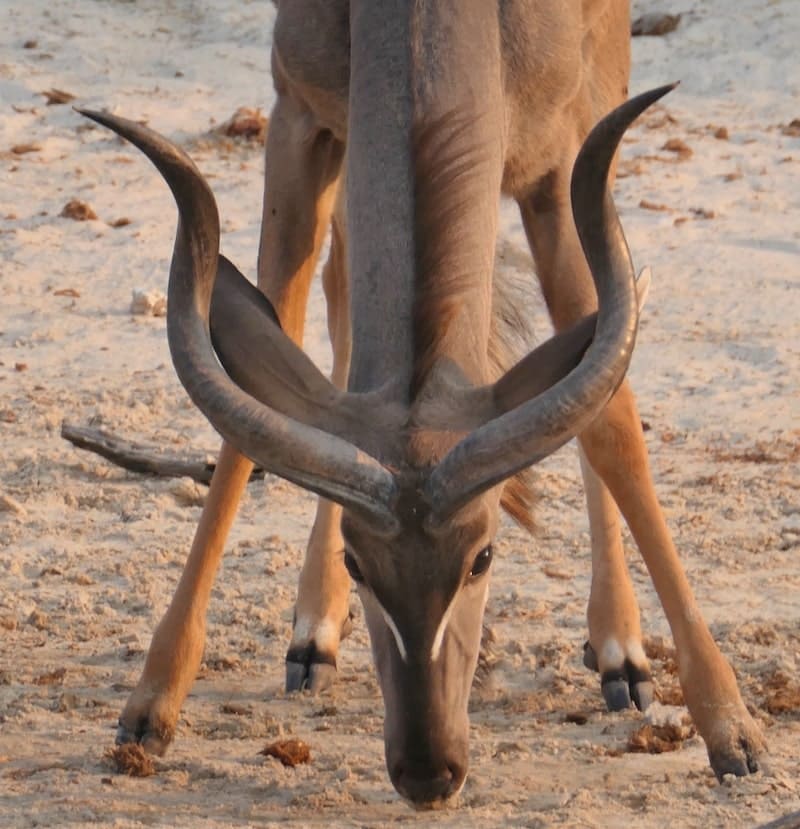 Kudu, Chobe National Park, Botswana
Kudu, Chobe National Park, Botswana
Tips on choosing an African safari
Below is a brief description of our African safari experiences and what we learned as a result, much of it framed as tips on choosing and booking an African safari.
Tip 1: Choose your region
Africa is a massive continent of 54 countries. Ten are renowned for world-class safari experiences: Botswana, Kenya, Mozambique, Namibia, Rwanda, South Africa, Tanzania, Uganda, Zambia, and Zimbabwe.
For us, wildlife viewing was a priority. We weren’t restricted to the ‘big five’ (elephant, lion, leopard, buffalo, and rhinoceros).
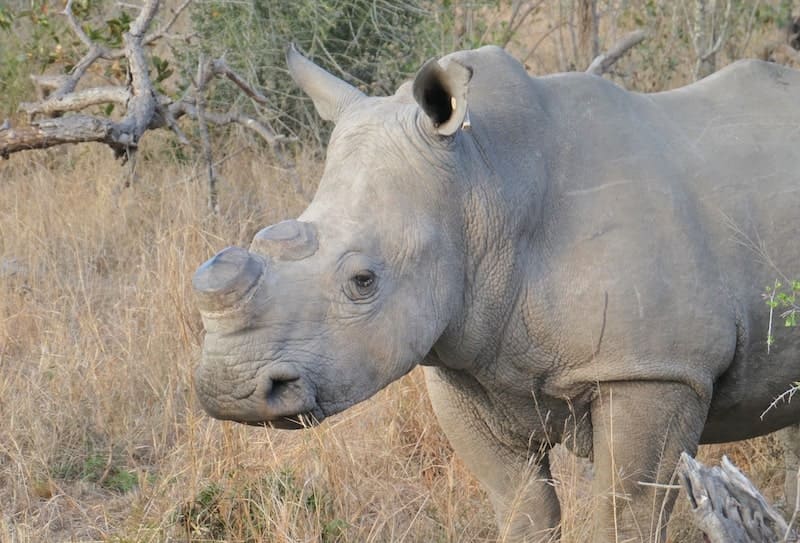 Rhinoceros, Thornybush Game Reserve, South Africa
Rhinoceros, Thornybush Game Reserve, South Africa
Our research on South Africa suggested we’d see the big five and a rich variety of other wildlife. In addition, we wanted to see herds of elephants crossing the Chobe River, the abundant bird life in the Chobe National Park, and many other animals such as hippopotamuses and crocodiles, that live in and beside the river.
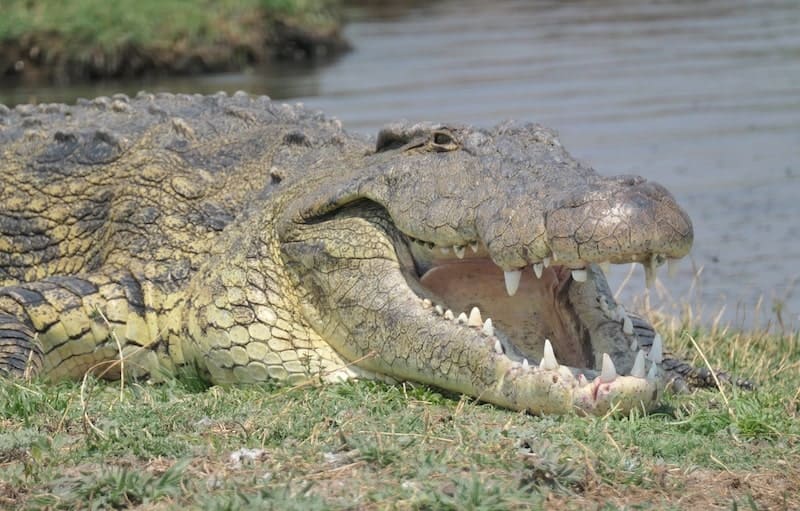 Nile crocodile, Chobe National Park
Nile crocodile, Chobe National Park
Our choice of southern Africa was influenced by our interest in seeing Victoria Falls, visiting the Apartheid Museum and Soweto in Johannesburg, and exploring Cape Town and the unique flora of the Cape. Had the Great Migration or gorilla trekking been at the top of our list, we would have looked further north to Tanzania or Rwanda. Next trip!
Tip 2: Identify the season
Once we’d chosen our region, research suggested September as an excellent month for wildlife viewing. From May to September, winter is the dry season, when wildlife gathers around permanent water sources. There’s less foliage, making animals easier to spot. Also, the temperature rises in September after the cold mid-winter months, suggesting more comfortable conditions for morning and evening drives. It’s the end of the dry season so we expected little, if any rain, and little chance of exposure to malaria. Our 46-day trip was from August 28 to October 12.
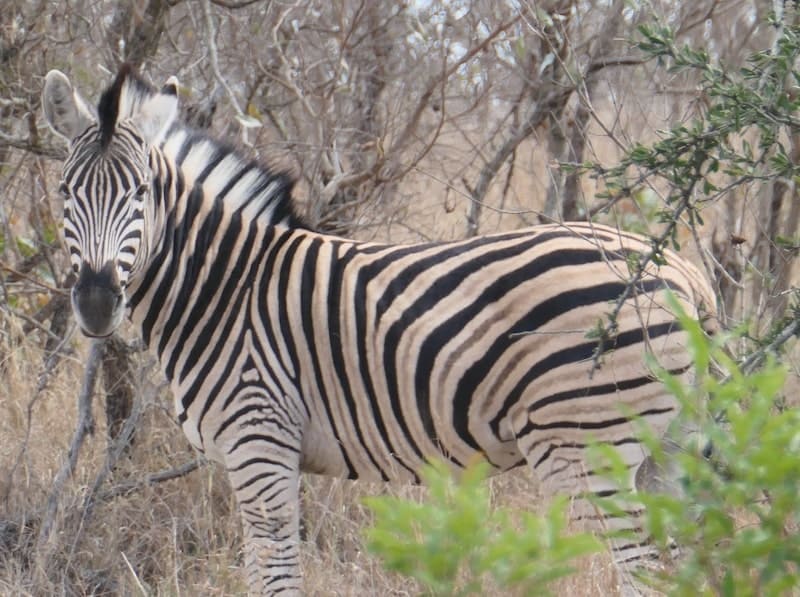 Burchell’s zebra, Thornybush Game Reserve, South Africa
Burchell’s zebra, Thornybush Game Reserve, South Africa
Tip 3: Establish a budget
A safari is not an inexpensive experience, and the longer the safari, the higher the cost. As budget-conscious travellers, we weren’t keen on a self-drive option or tented camps, and luxury accommodation was beyond our means. We figured three nights was the sweet spot for maximizing our exposure to various wildlife. It was an excellent decision for both safaris. Every drive was different, and the delightful anticipation felt before each one was exhilarating.
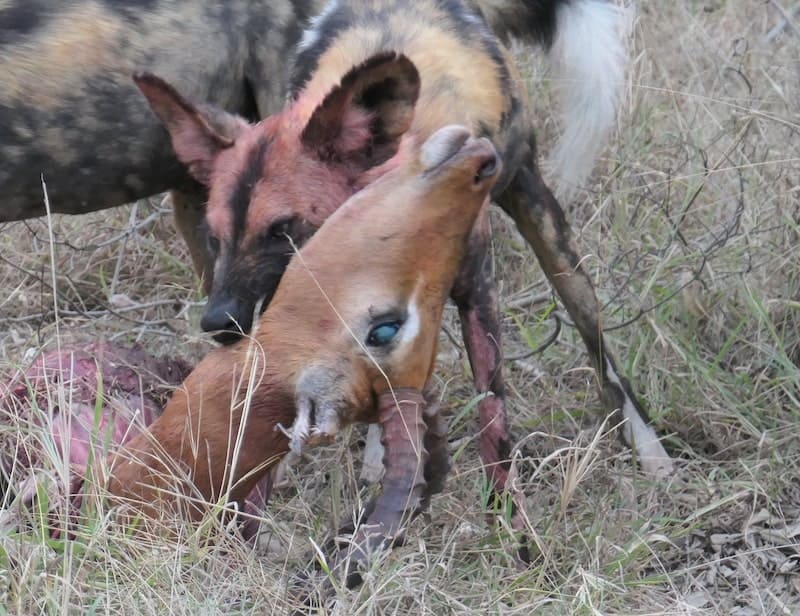 African wild dog, Thornybush Game Reserve, South Africa
African wild dog, Thornybush Game Reserve, South Africa
Tip 4: Choose your level of independence
Tour packages to explore a new destination are a perfect fit for many people. The tour operator develops a detailed itinerary, takes care of the bookings, and arranges local guides. We looked at several packages but it quickly became apparent we favoured a more independent model.
Packages with multiple stops in several countries within a short period didn’t appeal to us, and those that included flights, ground transportation, accommodation, excursions, and meals were very expensive. We could do it much cheaper by designing our itinerary, travelling at our preferred pace, and making our arrangements. Besides, as much as possible, we wanted a significant portion of our travel dollars to remain in Africa, so we made a conscious choice to refrain from using a North American company’s booking or tour services.
Another factor related to trip cancellation insurance. Many tour packages involve a non-refundable deposit with the remaining balance due 60 or 90 days before tour dates. This makes trip cancellation insurance a necessity, adding to trip costs. By making refundable bookings on accommodation and various experiences, we significantly reduced the non-refundable portion of our advance bookings. Most hotel bookings were refundable if cancelled within a day of arrival.
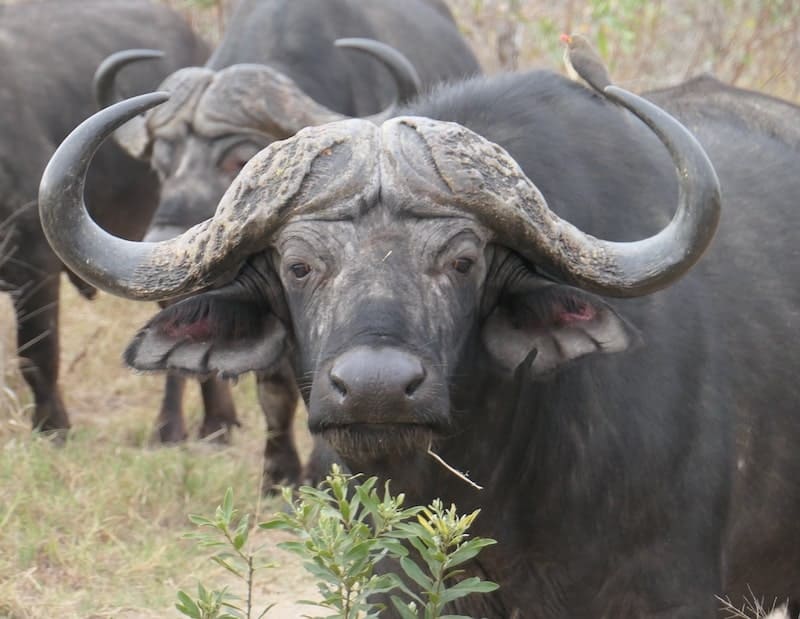 African buffalo, Thornybush Game Reserve, South Africa
African buffalo, Thornybush Game Reserve, South Africa
Tip 5: Choose safari dates with predicted energy levels in mind
A safari can be exhausting. Our land-based safari had two game drives each day; our river safari had three. Getting up at 05:00 and spending eight hours daily in an all-terrain vehicle or small river tender contributes to fatigue. It’s not an experience to tackle after a long flight. If you’re like us, missing a drive to rest was out of the question!
Also, choose dates with downtime and other activities in between if choosing two safaris.
Tip 6: Consider two safaris
I loved the two-safari combination. We met folks with the time and resources to enjoy a safari in Tanzania, one in Kenya, and another in South Africa on the same trip. For us, including a land-based safari and a water-based one not too far apart geographically was one of our best decisions.
They were very different, and each complemented the other.
My first sighting of an enormous elephant crossing the track just metres from our game-drive vehicle was a sight to behold. How could such an imposing, impressive animal move so quietly through the bush?
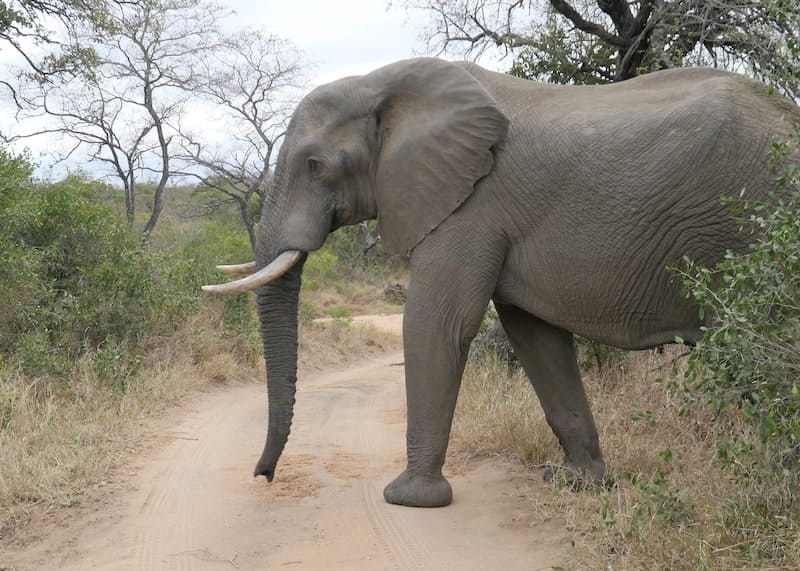 African elephant, Thornybush Game Reserve, South Africa
African elephant, Thornybush Game Reserve, South Africa
And then, in Chobe National Park, I watched elephants wallowing in a hollow of mud (that they’d created) and then spraying themselves (and us) with a mud bath using their extraordinary trunks. I’ll cherish these memories (and photographs), thanks to our decision to book two safaris.
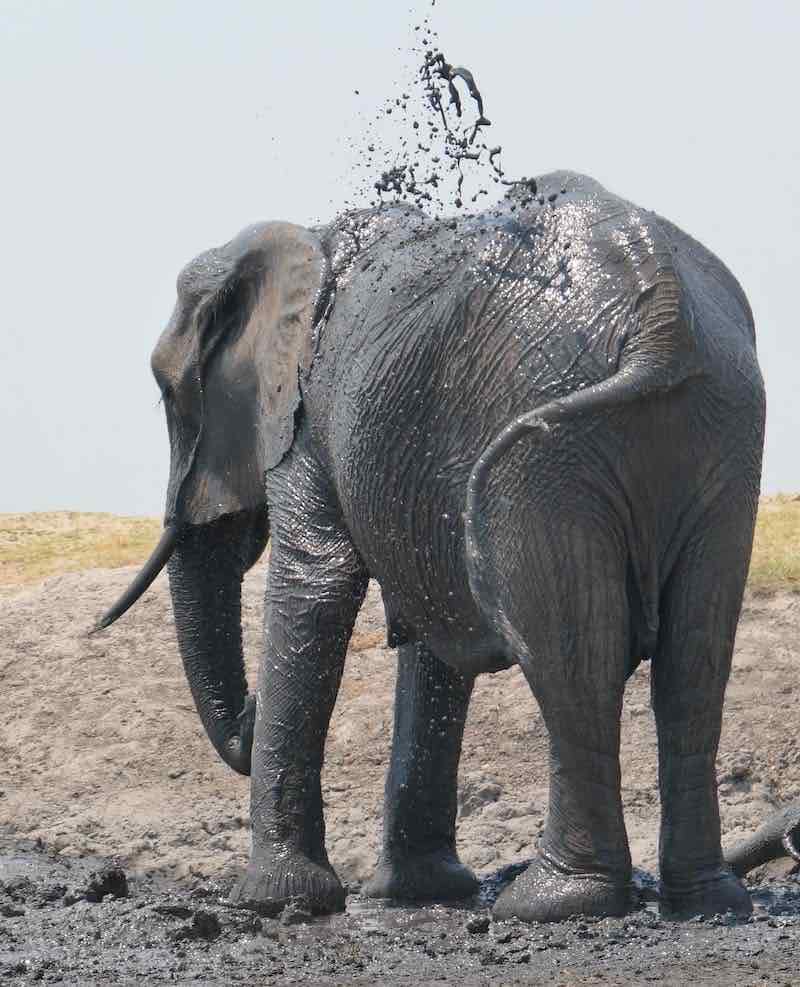 African elephant, Chobe National Park, Botswana
African elephant, Chobe National Park, Botswana
Tip 7: Investigate the remoteness of the safari location
Chances are a remote location means longer travel time, higher transportation costs, and heavier reliance on a tour operator to get you there.
Both of our safaris were easy to reach. This meant flexibility regarding transportation and what we chose to see and do on the way.
Jackalberry Lodge on the Thornybush Game Reserve is a short drive from Hoedspruit, South Africa. Airlink offers a direct flight from Johannesburg to Hoedspruit, but we booked an overland shuttle with Safari Link Southern Africa, to enjoy the beautiful landscapes between the highveld and lowveld areas of South Africa. Also, we were keen to tour the Hoedspruit Endangered Species Centre which was easily incorporated. Their cheetah program is impressive.
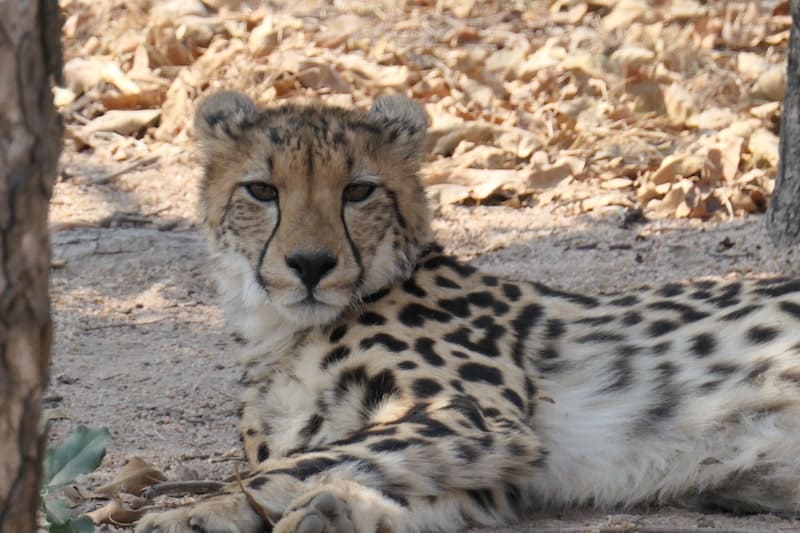 Cheetah, Hoedspruit Endangered Species Centre
Cheetah, Hoedspruit Endangered Species Centre
The Chobe Princess is based on the Chobe River in Kasane, Botswana. Kasane is served by the regional airline Airlink. However, we chose to stay a week in the Livingstone-Victoria Falls area and book a road transfer from Victoria Falls to Kasane, a distance of 85 kilometres (53 miles).
Tip 8: Size matters
The size of a property influences the variety and abundance of wildlife. An area of 3,000 acres compared to one of 30,000 will affect the quality of the game-viewing experience.
Our choice of Thornybush Game Reserve was based on several factors. It’s a 15,000-hectare (37,000-acre) private reserve sharing a 22-kilometre fenceless border with Kruger National Park. Compared to smaller properties, its size and open border with Greater Kruger Park suggested rich and diverse viewing opportunities. This proved to be the case.
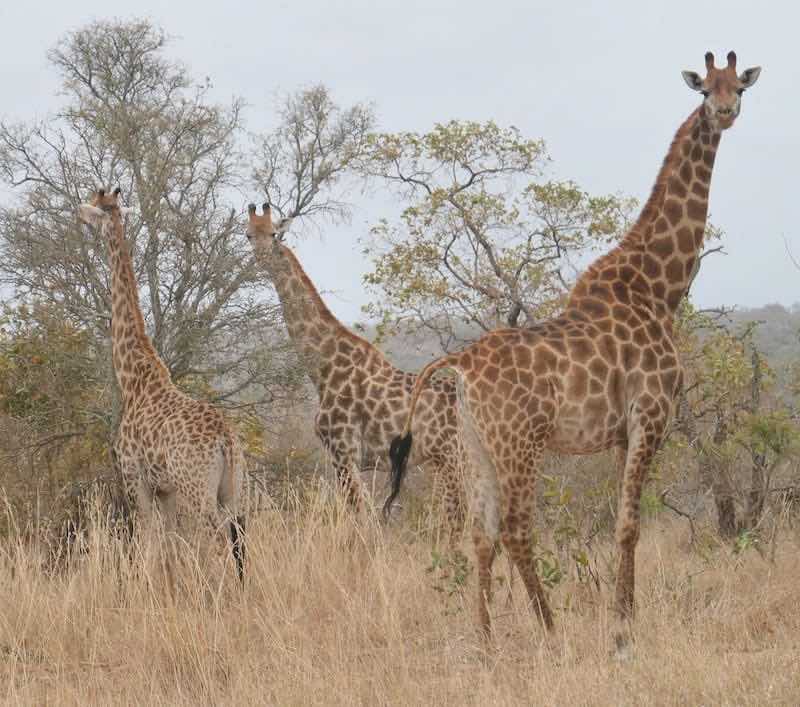 Giraffes, Thornybush Game Reserve, South Africa
Giraffes, Thornybush Game Reserve, South Africa
Tip 9: Consider the type of safari vehicle or boat
Other factors influencing our choice of Thornybush related to the game-drive vehicles.
- Their open-sided Toyota Land Cruisers feature three rows of seats at staggered heights. This helps guests feel like they’re part of the natural surroundings and closer to the animals. The tiered seats offer great views and superb opportunities to take photographs.
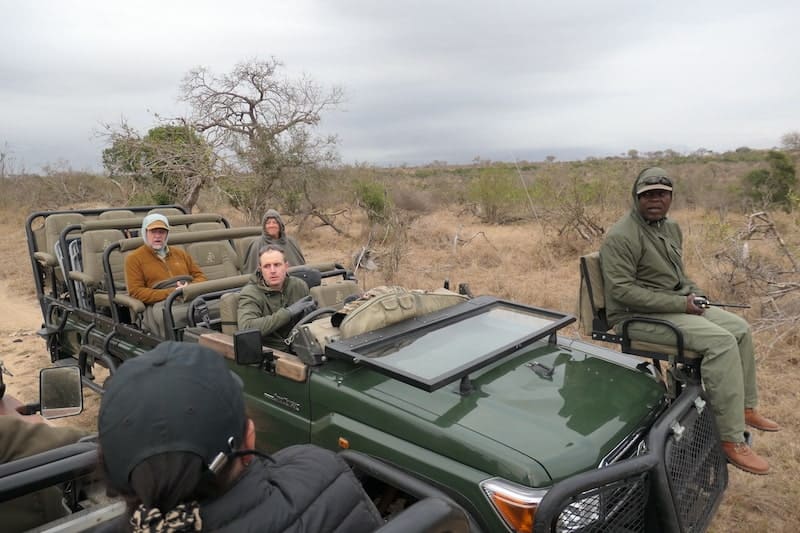 Toyota Land Cruiser, Thornybush Game Reserve, South Africa
Toyota Land Cruiser, Thornybush Game Reserve, South Africa
- They go off-road to cross rough terrain to pull up close to wildlife.
- Each vehicle has a bucket seat mounted on the front for a tracker to look for animal tracks and droppings. On multiple occasions, our tracker, Victor, capitalized on these clues to locate wildlife.
- In a private reserve, it’s less likely to see many vehicles vying for limited viewing space near wildlife. Most of the time, ours was the only vehicle a few metres away from a pride of resting lions or driving through an immense herd of buffalo.
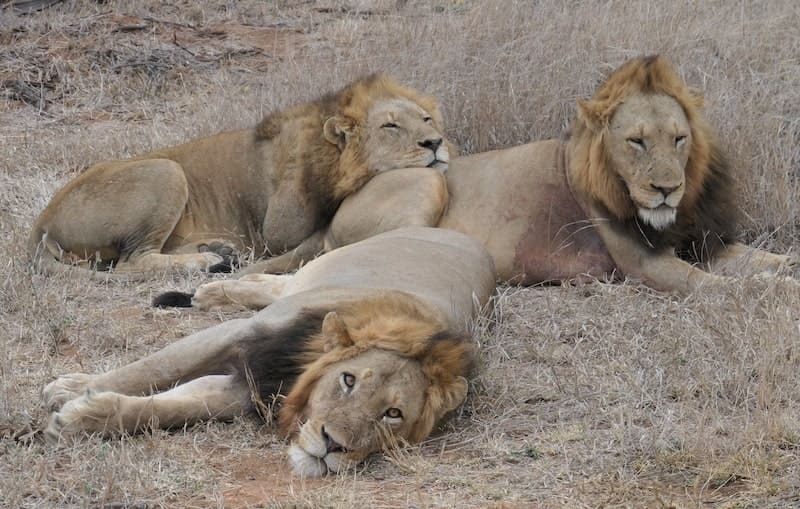 Lions, Thornybush Game Reserve, South Africa
Lions, Thornybush Game Reserve, South Africa
- Another advantage of a private reserve is that guides cooperate with their colleagues in other vehicles by two-way radio to share intel on the location of animals. As a result, we were occasionally joined by one or two other vehicles (at the most) that pulled up beside animals while we were there. It was common that as one vehicle arrived, another was leaving.
This contrasts with what I learned about the vehicles of a public reserve or national park. For example,
- No off-roading is permitted in Kruger National Park. Vehicles must stick to established roads.
- Vehicles must remain covered by law. While a canopy and canvas sides protect passengers from the elements, they can severely limit viewing opportunities.
- Traffic congestion at prime sightings is common, especially during the holiday periods. Guided game-drive vehicles share the public reserves and parks with self-drive ones.
- Trackers are not used in Kruger National Park, and game drives are limited to daylight hours.
Our Chobe River tender promoted an intimate viewing and learning experience. The small boat could navigate tight spots and with a maximum of eight passengers on board, we were able to ask our guide Allen questions and stay as long as necessary at viewing locations. This was a stark contrast to the large river vessels with two decks packed with tourists, presumably on a short day excursion from Victoria Falls.
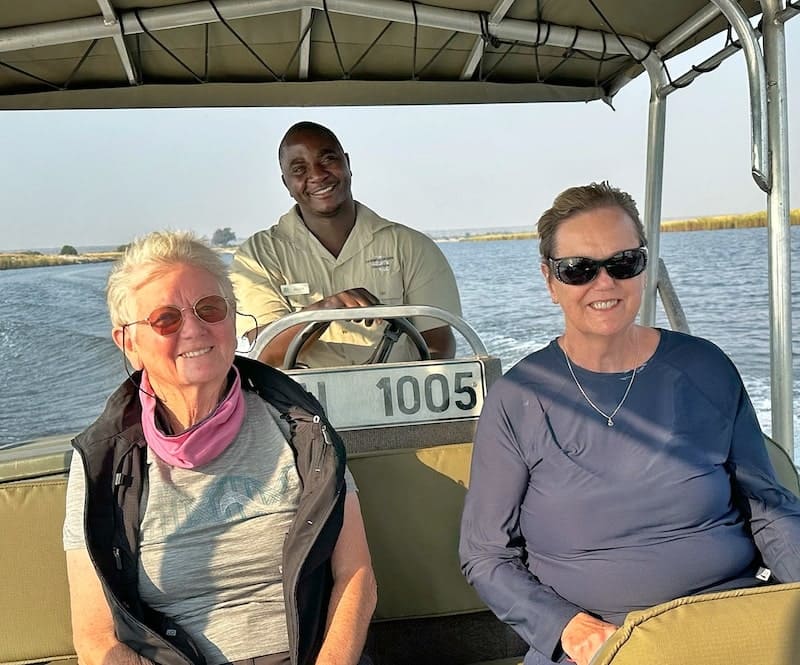 Tender, Chobe Princess II
Tender, Chobe Princess II
Tip 10: Do your research
For a first-time visit, I recommend choosing a guided safari over a self-drive experience.
We were very fortunate. It was a fortuitous discovery of two sets of friends in Nova Scotia who had experienced a safari in the Thornybush Game Reserve. Corinne (who stayed at Jackalberry Lodge) lent me her photobook of fantastic wildlife photos.
Helen and Lorne, who chose the more luxurious Thornybush Game Lodge regaled us with detailed descriptions of their stay. We asked a gazillion questions, and their intel was a tremendous help. Our friends described the vehicles, showed us their photographs, and elaborated on the comprehensive knowledge and professionalism of the guides and trackers. We learned that the food and beverages were top-notch and that the company engaged staff from the local area. We liked that Thornybush has a variety of accommodations to suit all budgets, from tented camps to luxury lodges. We chose a three-night stay at Jackalberry Lodge.
(Jackalberry Lodge will be closed for renovations beginning in February 2024.)
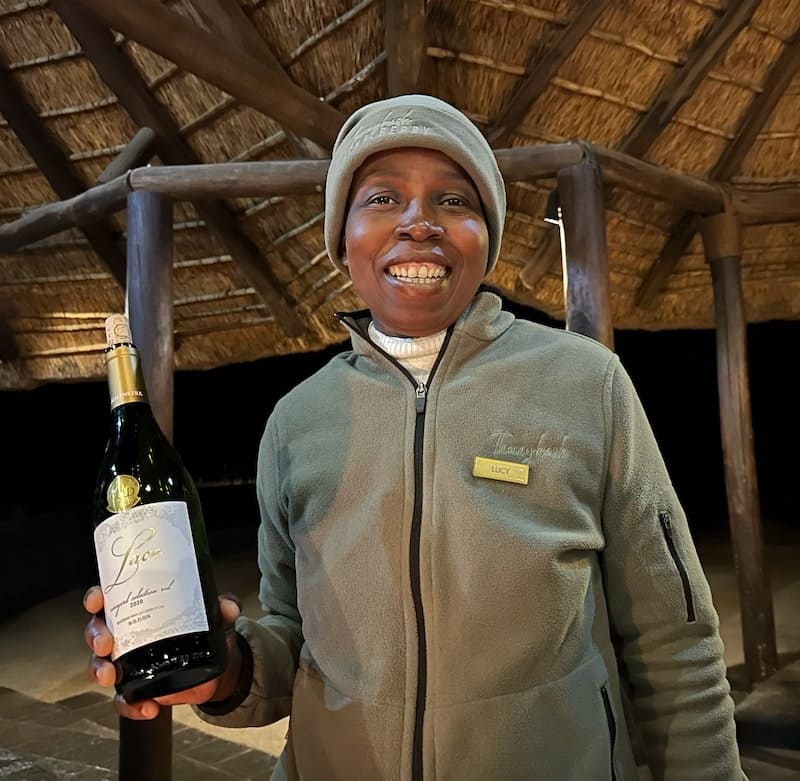 Lucy, Jackalberry Lodge, Thornybush Game Reserve, South Africa
Lucy, Jackalberry Lodge, Thornybush Game Reserve, South Africa
Without the recommendations of our friends, we would have been immobilized by so many choices. Otherwise, we would have contacted a few Africa-based safari specialists for suggestions and quotes based on our preferences and needs.
For our river safari, we booked three nights on an eight-passenger houseboat, the Chobe Princess II, part of the Zambezi Queen Collection. We stumbled upon this option early in our research. With the help of YouTube and many reviews, it was a straightforward decision. The houseboat changed location each evening, and there were three river drives each day in a tender with a canopy for protection from the sun.
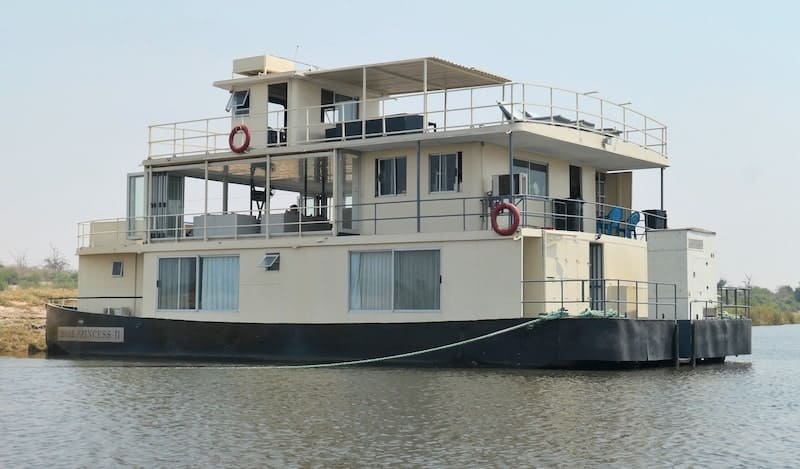 Chobe Princess II, Chobe National Park, Botswana and Namibia
Chobe Princess II, Chobe National Park, Botswana and Namibia
As a side note, having the Chobe Princess booking meant ignoring other cruises with an emphasis on wildlife viewing. For example, in Victoria Falls, we passed over cruises on the Zambezi River in favour of other activities.
Tip 11: Find a reliable Africa-based booking service
While we preferred to manage our bookings, we appreciated access to an Africa-based booking service.
The safaris were the ‘big-ticket items’ of the trip. My friend Janet and I shared accommodation, and for reasons associated with reward programs and trip cancellation insurance, we wanted to pay separately with a credit card of our choice. When we ran into difficulties doing so, we reached out to East Cape Tours, who not only accepted separate payments on various credit cards but offered a small discount for using their services.
We received excellent service from East Cape Tours. The company was a perfect fit for complementing our independent bookings.
If you’re planning a safari in Africa, you may be interested in the post, 16 Remarkable birds in Chobe National Park in Botswana.
If you found this article helpful, please share it by selecting one or more social media buttons. Have you experienced an African safari? If so, what other tips can you offer? Please share your thoughts in the comments. Thank you.
Care to pin it for later?
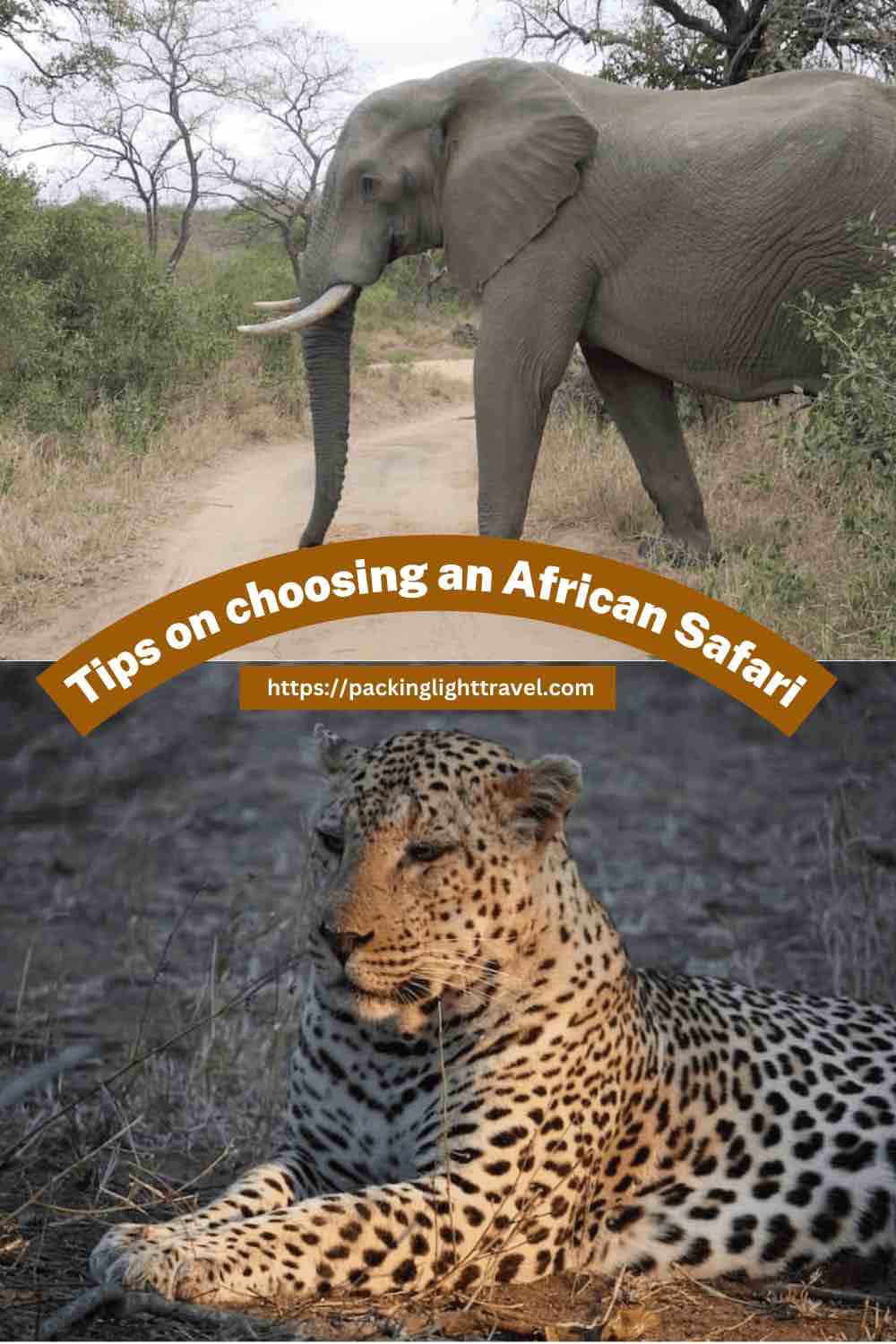

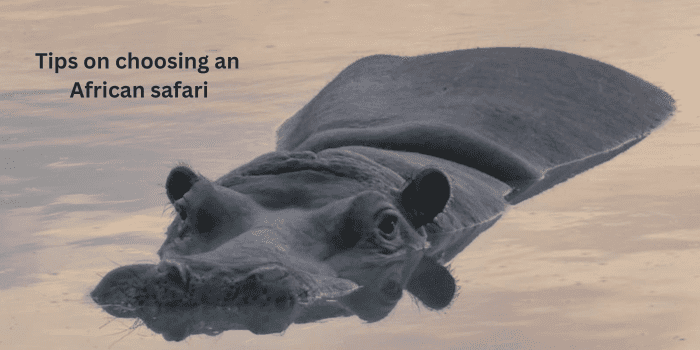




Very helpful tips! I agree with getting a guided safari for first-timers. I had my first safari experience in Udawalawe in Sri Lanka and having a guide helped me spot some animals and interesting facts about them!
All such helpful tips! I’ve never been on a safari before but I’d love to join a guided tour. It would be great getting insider tips and knowledge about animal spotting and facts about the animals. Thanks for sharing this!
Great tips! I will definitely saved this later, for when I book my next safari to Africa!
These are very helpful tips! I I went for the Maasai Mara safari in Kenya this April and I totally agree that for first-timers best to have a guided tour. My first safari experience with a guide helped me spot all the big 5 animals, and the vehicle I chose was perfect to see it all. I also agree that the season really matters if you want to see the animals before they migrate or if catching the migration is what you want. Thanks for this detailed guide.
Thanks for the useful in-depth tips for choosing a safari. I have been doing several safaris in Kenya and could relate to your experience. I have not done any water safaris yet, so it is something to consider for my future trips. Thanks for sharing!
Sharing this with my partner as we speak. A safari is definitely on our bucket list. Thanks so much for sharing your adventure, your magnificent pictures and all the great advice.